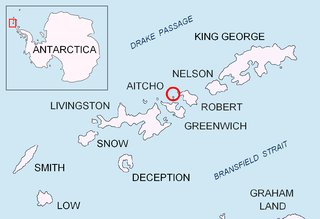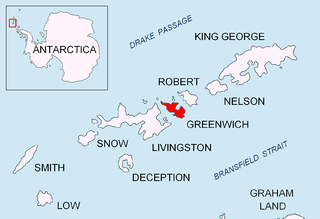
Makresh Rocks are a group of rocks situated 1.8 km (1.12 mi) northeast of Treklyano Island off the northeast coast of Robert Island, South Shetland Islands. Extending 600 m (656 yd) in west-southwest to east-northeast direction, and 270 m (295 yd) in northwest-southeast direction. The solitary Salient Rock62°21′24″S59°20′59″W is lying 1.73 km (1.07 mi) east of the midpoint of Makresh Rocks and 2 km (1.24 mi) northeast of Smirnenski Point.

Opaka Rocks are a group of rocks with the principal one situated 700 m (766 yd) north of Henfield Rock, 3.44 km (2.14 mi) east of Pordim Islands and 4.79 km west by south of Mellona Rocks off the north coast of Robert Island, South Shetland Islands. Bulgarian early early mapping in 2009. Named after the town of Opaka in northeastern Bulgaria.

Pordim Islands are two adjacent islands situated 870 m (950 yd) east-northeast of Heywood Island and 2.1 km (1.3 mi) northwest of Catharina Point on Robert Island, South Shetland Islands. Extending 960 m (1,050 yd) in east-southeast to west-northwest direction. The larger islet has a surface area of 10 hectares. Bulgarian early early mapping in 2009. Named after the town of Pordim in northern Bulgaria.

Maglizh Rocks are a group of rocks off the northwest coast of Smith Island, South Shetland Islands. The two adjacent principal rocks extending 460 m (503 yd) in east-west direction and 140 m (153 yd) wide are situated 300 m (328 yd) north of Lista Point, with the third major one, 300 by 100 m, situated 320 m (350 yd) northwest of them. Combined surface area 10.6 hectares. Bulgarian early mapping in 2009. Named after the town of Maglizh in southern Bulgaria.

Fort William Point is the conspicuous flat-topped rocky headland forming the northwest extremity of Coppermine Peninsula and Robert Island in the South Shetland Islands, Antarctica. The point is a northwest entrance point of English Strait and forms the west side of the entrance to Carlota Cove.

Barlow Island is a small ice-free island off the north coast of Smith Island in the South Shetland Islands, Antarctica extending 380 by 160 m, surface area 5.28 hectares.

Window Island is a small ice-free island off the north coast of Ray Promontory in the northwest of Byers Peninsula, Livingston Island in the South Shetland Islands, Antarctica. The island has a surface area of 23 hectares and rises to 72 m (236 ft). It was known to the early 19th century sealers operating on Byers Peninsula.

Table Island is a conspicuous flat-topped, rocky island lying north of Greenwich Island and north-northwest of the Aitcho group on the west side of English Strait in the South Shetland Islands, Antarctica. The island is rising to over 150 metres and extending 1.4 by 1 kilometre, with a surface area of 112 hectares. It is separated from Aitcho Islands to the south-southeast by the 1.9-kilometre (1.2-mile) wide Klimash Passage.

Morris Rock is rising to 55 m (180 ft) in the northwest extremity of Aitcho group, English Strait in the South Shetland Islands, Antarctica. The area was visited by early 19th century sealers.

Heywood Island is the largest of the islands off the north coast of Robert Island in the South Shetland Islands, Antarctica. It is named after Captain Peter Heywood, RN (1773–1831), commanding HMS Nereus off the east coast of South America in 1810–13, formerly a midshipman in HMS Bounty under Captain William Bligh. The area was visited by early 19th century sealers operating from nearby Clothier Harbour.

Eddystone Rocks is a group of two rocks lying to the northwest of Rugged Island off western Livingston Island in the South Shetland Islands, Antarctica.

Bowler Rocks is a group of rocks off the north coast of Greenwich Island in the South Shetland Islands, Antarctica lying southwest of Table Island and northwest of Aitcho Islands, and extending 1 km (0.62 mi) in east-west direction. The area was visited by early 19th-century sealers.

Chaos Reef is the confused area of breakers and shoal water in the north extremity of Aitcho Islands group on the west side of English Strait in the South Shetland Islands, Antarctica. The area was visited by early 19th century sealers operating from nearby Clothier Harbour.

Potmess Rocks is a group of large rocks lying northwest of Robert Island in the South Shetland Islands, Antarctica. The group is extending 1.3 by 1 km, featuring the conspicuous rocks named Asses Ears in the north. The area was visited by early 19th century sealers operating from nearby Clothier Harbour.

Lientur Rocks is a group of prominent adjacent rocks lying off the north coast of Robert Island in the South Shetland Islands, Antarctica and extending 660 m (722 yd) in east-west direction and 320 m (350 yd) in north-south direction. The area was visited by early 19th-century sealers operating from nearby Clothier Harbour.

Mellona Rocks is a group of scattered rocks lying at the north entrance to Nelson Strait in the South Shetland Islands, Antarctica and extending 1.7 by 0.9 km. The area was known to the early 19th-century sealers and sometimes included under the names 'Heywood Islands' or 'Powels Islands'.

Liberty Rocks is a group of four prominent adjacent rocks lying at the north entrance to Nelson Strait in the South Shetland Islands, Antarctica and extending 430 by 120 m. The area was visited by early 19th-century sealers.

Milev Rocks is the group of rocks off the north coast of Robert Island in the South Shetland Islands, Antarctica, situated east of Henfield Rock, south-southwest of Orsoya Rocks and southwest of Mellona Rocks, and extending 1.5 km (0.93 mi) in east-west direction and 600 m (656 yd) in north-south direction.

Priboy Rocks is the group of rocks off the east coast of Robert Island in the South Shetland Islands, Antarctica, extending 1.65 km (1.03 mi) in east-west direction and 1.2 km (0.75 mi) in north-south direction.

Vodoley Rock is the rock extending 220 m in northwest-southeast direction and 110 m wide in Barclay Bay on the west side of Ioannes Paulus II Peninsula on Livingston Island in the South Shetland Islands, Antarctica. The area was visited by early 19th century sealers operating on nearby Byers Peninsula and Cape Shirreff.













